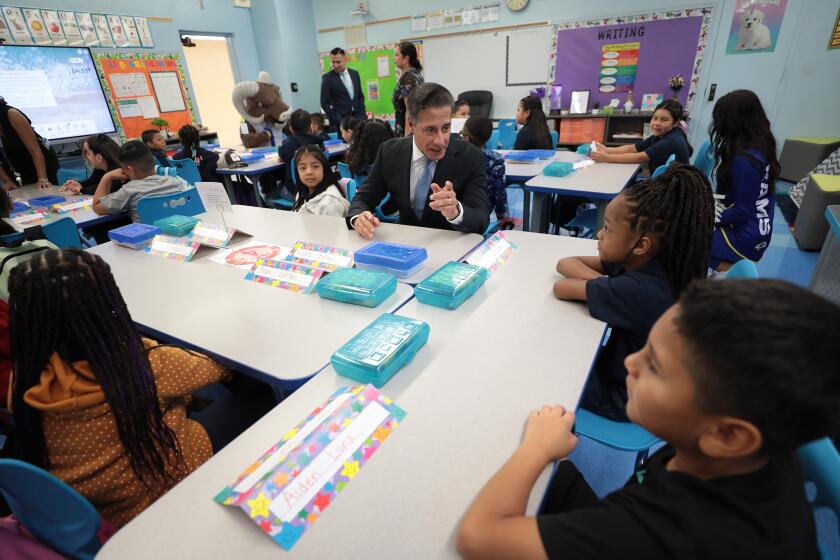LAUSD test scores hit a new high, erasing pandemic lows with a second year of strong gains

- Share via
- Scores went up in all tested grades for the second straight year in Los Angeles.
- Six years after the start of the COVID-19 pandemic, test scores have recovered.
- Achievement levels remain lower for Black students, although there were strong gains.
After years of struggling to recover from deep pandemic setbacks, Los Angeles Unified students have achieved a “new high watermark,” with math and English scores rising across all tested grades for the second straight year, surpassing results from before the 2020 campus closures, Supt. Alberto Carvalho said.
Two years of incremental gains at every tested grade level is generally considered solid evidence that instruction is moving in the right direction, said Carvalho, along with education experts.
“The coolest thing is that the district, despite all that this community went through, has now reached the highest-ever performance at all levels in English language arts and math,” Carvalho said in an interview with The Times. He formally announced the results Tuesday during his annual address to administrators and guests at Disney Concert Hall in downtown L.A.
“We didn’t just take it back to pre-pandemic levels. We exceeded pre-pandemic levels of performance,” he told The Times. “We established a new high watermark.”
Morgan Scott Polikoff, a professor at USC’s Rossier School of Education, described the gains as “indeed impressive and seem to have, in most cases, more than erased losses attributable to the pandemic. ... This is an important development and the district should be proud of it.”
Nonetheless, overall results show that achievement — as measured by test scores — in the nation’s second-largest school system remains a work in progress.
A look inside Los Angeles Unified’s migrant student summer programs offers a window into how Trump administration policies are affecting the classroom.
“Large proportions of students in the district, especially students from underrepresented racial and ethnic groups, are still performing below state standard,” Polikoff said.
In total, 46.5% of students met or exceeded grade level standards in English Language Arts in tests conducted in April and May. In math, the figure was 36.7%. The overall numbers indicate that nearly 2 in 3 students are not meeting the math standards for their grade in the school system of about 400,000 students.
Brights spots in the scores

But the scores look better in the details.
In math, for example, the percentage of students testing as proficient or better improved by 3.92 percentage points, a strong gain for one year. Last year, the gain was 2.3 percentage points — also a solid gain — bringing L.A. Unified, at the time, to within 2.7 points of the entire state. It’s possible that L.A. Unified overtook the state average this year in math — although statewide data has yet to be released.
This year’s gains appeared to be across the board — reaching students with disabilities, students from low-income families, Latino students and Black students.
The percentage of Black students testing as proficient or better improved at least four percentage points in both English and math. Nonetheless, 3 in 4 Black students still are not achieving grade-level standards in math. The number is better but still low for reading, with 36% of Black students meeting or exceeding the state standards for their grade.
In another positive development, the achievement gap narrowed slightly between Asian and white students compared to Black and Latino students. Researchers have noted that these gaps widened across the nation during the pandemic.
Even so, a sizable gap remains. For example, in math, nearly 80% of Asian students and nearly 70% of white students were deemed proficient, compared to 31% of Latino students and 25% of Black students.
Data from this parameter is crucial to track, said UC Berkeley emeritus professor of education Bruce Fuller.
All the same, “this post-COVID bounceback in student learning is quicker and reaching higher levels than observed in most school districts across the state.”
Fuller also attributed success to the district’s long-term efforts — scores had been gradually improving before the pandemic.
“Public schools have successfully lifted the education attainment of Angeleno parents in recent decades, which helps explain their children’s stronger success in school,” he said.
States sue over billions in federal education funding that was supposed to begin flowing July 1. Trump officials are reviewing the congressionally approved funding.
Carvalho told The Times that the most recent scores — which reflect tests taken in the spring — were especially impressive in context.
In anticipating the results, “I had fear in my heart to a certain extent,” he said.
“You know the disruptions. We had to shut down the system because of the inclement conditions, some of it weather, but some of it smoke, ash and all that as a result of fires. And then the immigration raids. The stress. The fears.”
“This was a year without precedent for us,” he said.
In his 90-minute address, Carvalho talked at length about the trauma of the fires and immigration enforcement — and the admirable response of district staff to each — while also taking digs at the Trump administration.
“The federal government swung its budget ax with all the care of a toddler running with scissors,” he said. “Let’s be honest, if Washington had a model for federal funding, it would be, ‘If I can’t spell it, I’ll defund it.’ And I think, judging by the vocabulary, we should all be very, very afraid, for it is limited.”
“District schools have endured something no learning community should ever have to withstand,” he added, “weeks of immigration raids, helicopters overhead, militarized vehicles in our streets, uniformed agents near school gates and graduations — and a rising tide of fear in hallways and classrooms.”
He looked into the audience: “You showed up. Our educators showed up. You opened doors. You offered common care. When no easy answers existed, you kept heart steady while uncertainty knocked loudly outside.”
It was a receptive audience for Carvalho’s pro-immigrant message — which included inviting a student mariachi group to sing the U.S. national anthem and a closing ballad — with students filling the stage singing “We Are the World.”
The audience of mostly administrators joined in by waving their lit-up cellphones.
Long trail of recovery

The sharp decline of test scores began in March 2020, when L.A. Unified campuses shut down for more than a year during the pandemic, forcing classes online. That long-running public health emergency — a time of job losses, disease and higher death rates — demonstrably drove down student performance on the standardized tests.
Carvalho became superintendent in February 2022.
During the more recent crises, students and staff have largely soldiered through with better outcomes.
A slide prepared for Carvalho’s Disney Hall presentation touted the gains as the “Highest-Ever Achievement.”
What that means is that, overall, L.A. Unified has never performed better as measured by the current state testing system, which began collecting data in 2015. L.A. Unified also had not previously improved across all grades for two years in a row, district officials said, during the 11 years of the current testing regime.
Students are tested in English and math in grades 3 through 8 and grade 11. In science, student are tested in grades 5 and 8, and once during high school. In these relatively new science tests, scores remain especially low, although they improved. Overall, 27.3% of students met the state standards in science.
What contributed to the gains
The testing rebound was helped by record levels of state and federal funding to cope with the harms of the pandemic.
Carvalho, whose contract expires next February, said that the district used the one-time money effectively and, although it is gone, the system in place should continue to build on the academic gains.
He listed a number of key initiatives as contributing to gains, such as giving more resources and applying more oversight to schools and groups of students who needed more help. He also cited better data and an ability to use it faster to tailor instruction.
Tutoring — before, during and after school, and in-person and online — was a central strategy. So was increasing classroom instructional time by promoting summer school and offering mini-academies during winter and spring break, he said.
Intervention teachers were deployed to work with small groups of students, and coaches helped refine teaching.
Some of these efforts pre-dated Carvalho’s arrival from Miami, where he had been the longtime superintendent.
Challenges ahead
The challenges ahead involve more than improving the quality and pace of learning.
“One of my biggest concerns is really the unpredictability of the moment in which we live, the instability of funding, but also the unpredictability and instability of policy that influences public education,” Carvalho said.
The L.A. school board approved an $18.8 billion budget that postpones layoffs for a year and does not cut services to students. But future years may looking much different.
The U.S. Supreme Court recently cleared the path for massive layoffs at the U.S. Department of Education, as one example.
“What does that really mean in terms of at the local level for a student?” Carvalho said.
In addition, enrollment has declined steadily for about 20 years.
Ongoing immigration enforcement could accelerate that trend, Carvalho said.
“We have a very large number of immigrant students, or students who are children of immigrant parents with mixed status,” Carvalho said. “I have to believe, based on stories I read and reports that I watch, that there will be families, unfortunately, in our community, who have made a decision to self-deport with their children.”
More to Read
Sign up for Essential California
The most important California stories and recommendations in your inbox every morning.
You may occasionally receive promotional content from the Los Angeles Times.

















